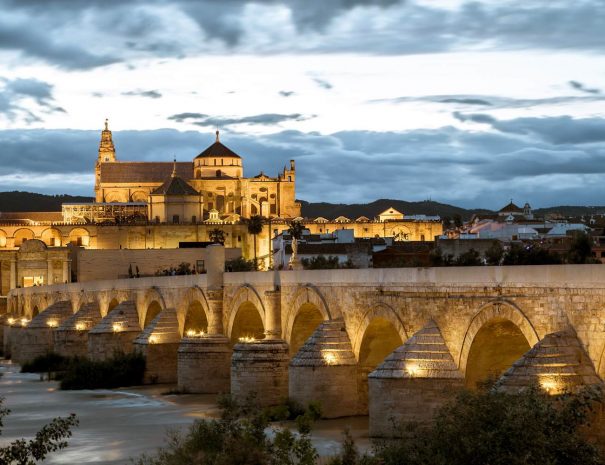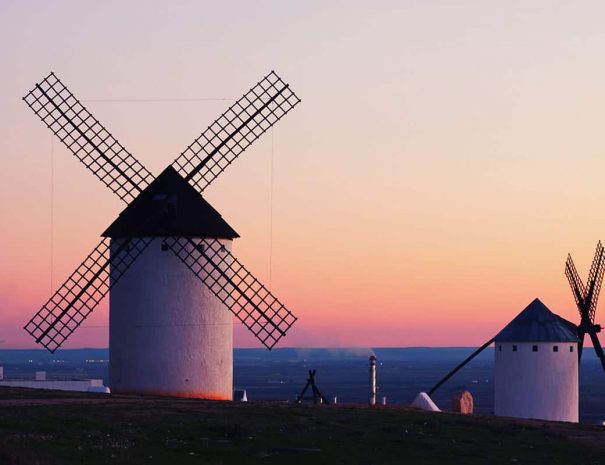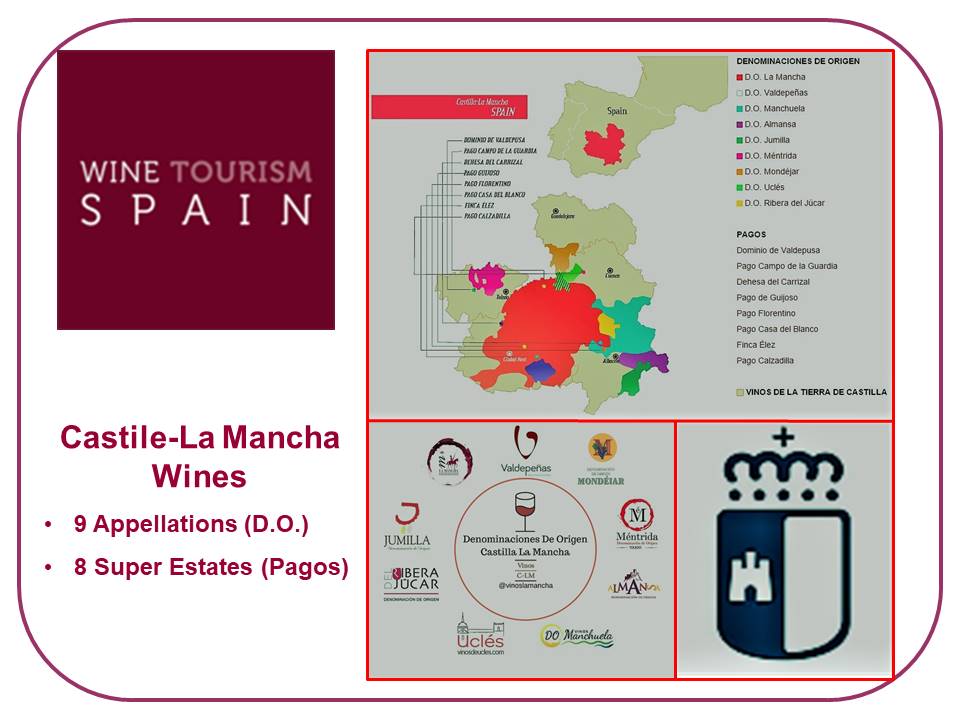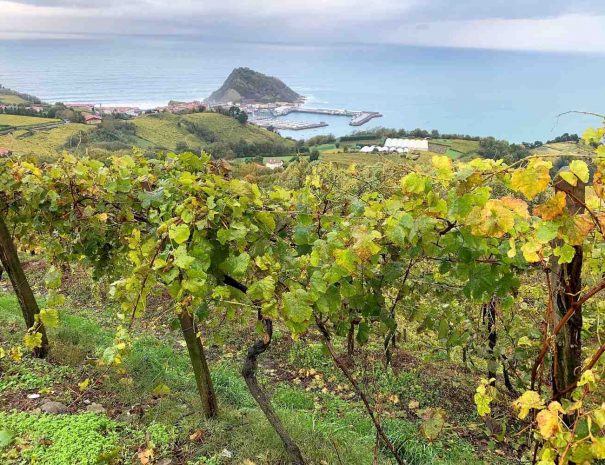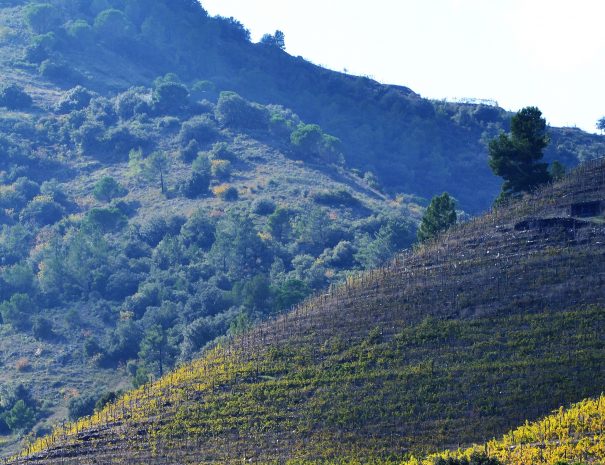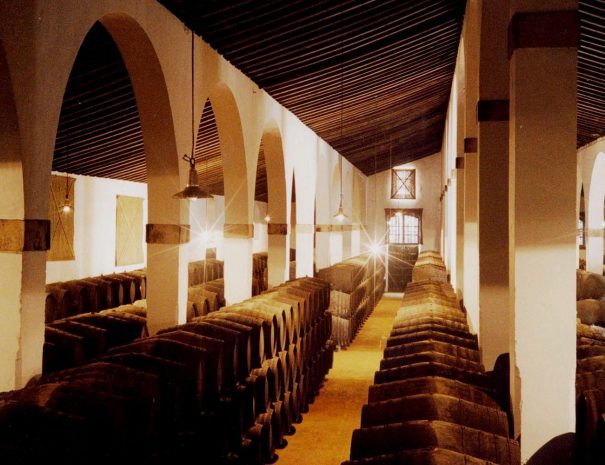D.O. Almansa (1966)
Almansa is a famous village because of its amazing castle. The wine region around has a small size and it is located on the Southeastern corner of Castile-La Mancha. It extends over more than 7,000 ha (17,000 acres) in 8 villages and has 12 wineries. The climate is harsh, dry, semiarid, and continental (very cold winters and very hot summers). The vinyards altitude is above 700 masl (2300 ft). Its wines are classified according to the following categories:
- Young wines (white or rosé)
- Barrel fermented and/or oak-aged white wines for at least an aging of 18 months adding oak and bottle period with at least 6 months in oak.
- Young reds and/or short-term oak-aged red wines (at least 3 months in oak).
- Medium-term oak-aged red wines: Crianza for at least an aging of 24 months adding oak and bottle period with at least 6 months in oak.
- Long-term oak-aged reds: Reserva for at least an aging of 36 months adding oak and bottle period with at least 12 months in oak.
Gran Reserva for at least an aging of 60 months adding oak and bottle period with at least 18 months in oak.
- Sparkling wines: Champenoise Method. ‘Reserva’ is labeled for those wines that have been aged within the bottle for at least 24 months.
- Semiseco / Semidulce / Dulce (Semidry / Semisweet / Sweet)
The traditional terminology that is used to classify D.O. Almansa’s wines is:
- Crianza, Reserva, Gran Reserva
- Añejo, Noble, Superior, Viejo (Old), Rancio (Rancid)
The most important red grapes within the D.O. are Garnacha Tintorera and Monastrell (Mourvedre). Other allowed varieties are Cabernet Sauvignon, Garnacha (Grenache), Merlot, Petit Verdot, Pinot Noir, Tempranillo, and Syrah. The allowed white grapes are Chardonnay, Sauvignon Blanc, Small Berry Muscat, and Verdejo.
D.O. La Mancha (1932)
Welcome to the largest vineyard surface wine region in the world. The D.O. La Mancha is located on the South Plateau of the Iberian Peninsula which means a drive of 1h30min from Madrid.
The huge size of this region allows a wide range of grape production. The allowed white varieties are Airen, Chardonnay, Gewürztraminer, Macabeo (Viura), Parellada, Pedro Ximenez, Riesling, Sauvignon Blanc, Small Berry Muscat, Torrontes, Verdejo and Viognier. The available allowed red berries are Bobal, Cabernet Franc, Cabernet Sauvignon, Garnacha (Grenache), Graciano, Malbec, Mencia, Merlot, Monastrell (Mourvedre), Moravia, Petit Verdot, Pinot Noir and last but not least Tempranillo (Cencibel).
This is the La Mancha wine classification:
- Young Wine (red, rosé or white)
- Traditional Wine
Those who were aged in the tank. This also works for naturally sweet white wines.
- Wines aged in oak barrels for at least 60 days.
- Crianza wine
2 years of aging, one of them must be in barrel and bottle.
- Reserva wines, with at least 12 months aging in oak plus at least 24 more months in the bottle.
- Gran Reserva wines, with at least 24 months aging in oak plus at least 36 more months in the bottle.
- De aguja (Semi-sparkling wine). These wines present a fizzy touch due to the remaining CO2 from the fermentation process.
- Espumoso (Sparkling). Made by the traditional method (Champenoise), with at least 9 months of bottle aging.
D.O. Manchuela (1996)
Located on the Eastern corner of Castile-La Mancha exactly between the valleys of the rivers Jucar and Cabriel, la Manchuela enjoys a continental climate like the other Castile-La Mancha wine regions but it is under the influence of the moist ‘Levant winds’ that approach from the Mediterranean coast on the east.
These are its types of wines:
- White Wines
- Cask fermented White wines and/or cask-aged white wines
- Rosé Wines
- Red Wines
- Cask-Fermented Red Wines
- Cask-aged Red Wines
These are red wines that have been aged for at least two months in oak casks.
- Carbonic Maceration Red Wines
- Crianza Wines
- Reserva Wines
- Gran Reserva Wines
- Sparkling White and Rosé Wines
The main red grape varieties are Bobal and Tempranillo (Cencibel). For whites is Macabeo (Viura). Other allowed white varieties are Albillo, Chardonnay, Small Berry Muscat, Pardillo, Sauvignon Blanc, Verdejo and Viognier. The additional allowed red berries are Cabernet Franc, Cabernet Sauvignon, Tinto Velasco (Frasco), Garnacha (Grenache), Garnacha Tintorera, Graciano, Malbec, Mazuelo, Merlot, Monastrell (Mourvedre), Moravia Dulce (Crujidera), Moravia Agria, Petit Verdot, Pinot Noir, Rojal and Syrah.
D.O. Mentrida (1976)
Mentrida is a village that gives name to a Denominación de Origen (DO) for wines covering 26,000 ha (64,000 acres) within the province of Toledo (heading west from Madrid). There are three distinctive subzones: Talavera de la Reina, Torrijos, and La Sagra, being the majority of the vineyards around Torrijos (71%).
The wine region has a very extreme continental climate with very long hot summers, really dry and cold winters, and a wide gap between day and night temperatures. The average rainfall is between 300–450 millimeters (12–18 in) per year therefore the vines have been traditionally planted as low bushes (Vaso in Spanish, Gobelet in French) although new vineyards with irrigation drips are planted on trellises. The soils are poor in organic matter with a loose sandy-clay consistency. The vineyards’ altitude goes from 400 to 800 masl (1,300 to 2,600 ft) where Garnacha (Grenache) represents over 80% of the vines planted. The remaining 20% goes for the other authorized red varieties: Cabernet Sauvignon, Merlot, Syrah, Tempranillo (Cencibel), and a very small proportion of white varieties such as Albillo, Chardonnay, Macabeo (Viura), and Sauvignon Blanc.
D.O. Mondejar (1997)
Mondejar is a Denominación de Origen (DO) by 65km heading east from Madrid thus it is bordering on the D.O. Vinos de Madrid to the west and on the D.O. Ucles to the south. The vineyards are high in altitude (around 800 masl, 2,600 ft), spread out on gently rolling hills, and with a low-density profile (about 1,100 vines/ha).
Mondejar wines have been focused traditionally on their local market but this is changing little by little. The authorized white varieties are Macabeo, Malvar and Torrontes. The main red varieties are Cabernet Sauvignon and Tempranillo (Cencibel).
D.O. Ribera del Jucar (2003)
Ribera del Jucar is a small D.O. that covers 9,141 ha (22,587 acres) and by the way, it means ‘Jucar Riverbanks’ so it extends basically on the right bank of the Jucar river on its way down to the Mediterranean Sea. The altitude is around 750 masl (2,460 ft) that ensures a Continental climate with Mediterranean influence and, like many other wine regions in Castile-La Mancha, the area suffers a serious lack of rainfalls. The main red varieties are Bobal and Tempranillo (Cencibel) plus a bunch of French authorized varietals such as Cabernet Franc, Cabernet Sauvignon, Merlot, Petit Verdot, and Syrah. The range for whites is much shorter: Small Berry Muscat and Sauvignon Blanc.
D.O. Ucles (2005)
Ucles is a small village, famed because of its Moorish Castle and its important Saint James (Santiago) devoted Monastery. But Ucles is also a modern wine region with pretty similar conditions to its neighboring D.O. Mondejar. The soils are not very fertile being possible to split the D.O. into three different landscapes:
- Sierra de Altomira (Altomira´s Range): Rough and mountainous.
- Western zone: Rolling hills.
- Eastern zone: Intermediate depression.
The white authorized grape varieties are Chardonnay, Macabeo (Viura), Small Berry Muscat, Sauvignon Blanc, and Verdejo. The red ones are Cabernet Sauvignon, Garnacha (Grenache), Merlot, Syrah and Tempranillo (Cencibel).
D.O. Valdepeñas (1932)
Valdepeñas is a very well-known and traditional Manchego town not very far from the Andalusian border to the south and almost surrounded by the D.O. Mancha to the other three cardinal points. There is a long history of winemaking easy to observe just getting into the caves that are under the town center. The traditional wine style called ‘Aloque’ or ‘Clarete’ makes distinctive this D.O. if we compare it with the D.O. Mancha which consists in mixing white and red grapes before the fermentation process. The wine region is large considering its 22,332 ha (55,184 acres) that produced by a hundred million kilos of grapes.
Valdepeñas has been a wine-producing region since Roman times. The traditional fermentation vats were made of clay till the forties (XX Century) when many of them were substituted by concrete and later on by stainless steel. The train changed the way of shipping wine from Valdepañas; in 1861 was possible to transport wine to a harbor and ship it to The Philippines or South America. In 1895 Madrid was targeted. But everything collapsed when in 1911 the phylloxera plague destroyed the vineyards, forcing the vine-growers to replant a grafted vine and most of them chose the same solution: an American rootstock plus Airen variety (a big part of it has been traditionally used for brandy distillation).
Like the other seven Manchego appellations (we do not mention Jumilla on this chapter because is mainly a part of Murcia), the climate is continental and quite extreme (big temperature gap between days and nights and between summers and winters) and because of the lack of water and common droughts, it could be classified as semiarid. Soils are poor in organic matter.
The authorized white varietals are Airen, Chardonnay, Macabeo (Viura), Verdejo, Sauvignon blanc and Small Berry Muscat. The authorised reds are Cabernet Sauvignon, Garnacha (Grenache), Merlot, Petit Verdot, Tempranillo (Cencibel) and Syrah.
According to the aging process we have these categories:
- Young wines (for whites, rosés or reds)
- From shoter to longer oak-aged wines: Crianza, Reserva and Gran Reserva.
- Vino de la Tierra de Castilla (IGP/VT) (1999)
This is one of the most important Spanish geographical indications that works under the calification ‘Vino de la Tierra’ (Wine of the land -of Castile-) for all that wines which are produced and controlled within the autonomous community of Castile-La Mancha. Vino de la Tierra is a modern concept, less strict about what you can grow and how and therefore is considered one step below the D.O. concept but it offers a good solution for any winery to compete internationally with better arms and sometimes the resulting wine could be as good as the D.O. one or even better.
Available authorised white varietals: Airen, Albillo, Chardonnay, Macabeo (Viura), Malvar, Merseguera, Pardillo (Marisancho), Pedro Ximenez, Sauvignon blanc, Small Berry Muscat and Torrontes.
Available reds: Bobal, Cabernet Sauvignon, Coloraillo, Garnacha (Grenache), Garnacha tintorera, Merlot, Monastrell (Mourvedre), Moravia Agria, Moravia Dulce (Crujidera), Negral (Tinto Basto), Petit Verdot, Syrah, Tempranillo (Cencibel), Tinto Velasco (Frasco).
